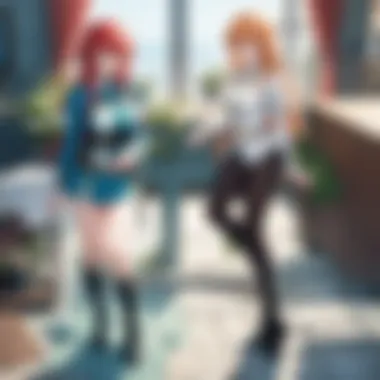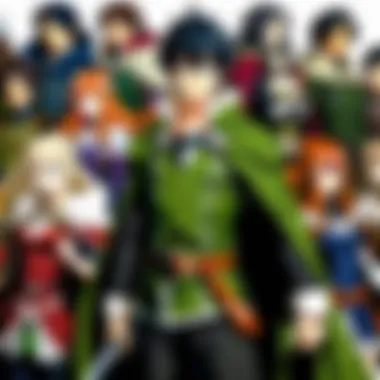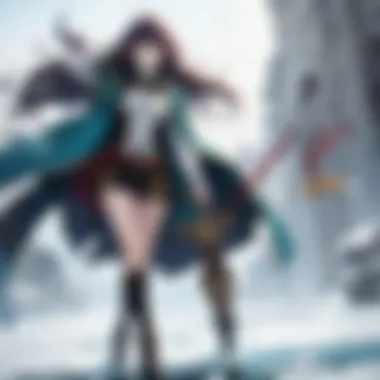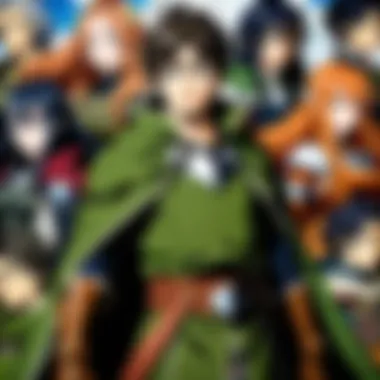The Rising of the Shield Hero: Season One Analysis


Intro
The Rising of the Shield Hero has garnered considerable attention since its debut. The series presents a unique interpretation of the isekai genre, blending traditional tropes with innovative narratives. This analysis will explore the intricacies of Season One, detailing how its narrative structure, character development, and thematic elements contribute to its popularity.
Series Overview
Synopsis and Premise
The story follows Naofumi Iwatani, a typical otaku who finds himself transported to a fantasy world. This world has a clear hierarchy of heroes, each representing different weapons. Naofumi is assigned as the Shield Hero, a role deemed less prestigious and brings him upon a path of betrayal and hardship. After being falsely accused of a crime, he becomes isolated and cynical. The first season emphasizes Naofumi’s growth from a distrustful figure to a determined protector, underscoring his journey of self-discovery.
Notable Characters
- Naofumi Iwatani: The protagonist whose character arc is central to the narrative.
- Raphtalia: A demi-human and Naofumi's companion. Her growth parallels Naofumi's.
- Filo: A creature with the ability to transform, adding depth to the hero's journey.
- Malty Melromarc: The antagonist whose manipulation triggers Naofumi's transformation.
These characters form the backbone of the series, offering various perspectives on the themes of trust, loyalty, and betrayal.
Themes and Motifs
Major Themes Explored
The series delves into several significant themes:
- Betrayal and Trust: Naofumi’s betrayal shapes not only his character but also the overall narrative.
- Resilience: Naofumi’s journey exemplifies the idea of rising against adversity.
- Redemption: Characters such as Raphtalia grow through their experiences alongside Naofumi.
Symbolism in Storytelling
The shield itself carries strong symbolism throughout the season. It represents protection, but also reflects Naofumi's emotional barriers. Observing the evolution of this symbol provides insight into the deeper narrative meanings and character motivations.
Artistic Style and Animation
Visual Aesthetics and Design
The Rising of the Shield Hero employs a visually striking style that enhances the storytelling. The character designs are distinct, reflecting their respective roles and personalities in the narrative. The intricate landscapes of the fantasy world are well-executed, providing audiences with immersive visuals.
Animation Techniques and Trends
The animation quality stands out, particularly during combat scenes. The use of motion and pacing captures the intensity of the battles. Techniques such as dynamic camera angles and fluid character movements contribute to the overall engagement of the viewer. These elements not only draw viewers into the action but also highlight the significance of every encounter Naofumi faces.
"The visual storytelling complements the emotional arcs, making each moment impactful."
This overall analysis of Season One reveals layers of complexity not only in character arcs but also within the broader narrative framework. It is vital to consider the cultural impact and how the themes resonate with audiences today. As the series progresses, examining its reception and influence on the anime landscape will provide further context for its success.
Prolusion to The Rising of the Shield Hero
Understanding the significance of The Rising of the Shield Hero is vital for any exploration of anime narratives in the modern era. This series stands out due to its unique approach to the isekai genre, combining themes of redemption and betrayal with a distinctive narrative twist. This section aims to set the stage for a deeper discussion, highlighting its key elements and providing context for the analysis that follows.
Overview of the Series
The Rising of the Shield Hero premiered in 2019 and quickly garnered attention among anime enthusiasts. The series follows Naofumi Iwatani, an otaku who finds himself transported to a fantasy world. His initial excitement transforms into disillusionment as he becomes the target of false accusations. This sets him on a journey marked by struggles and growth, leading to complex relationships with his companions, particularly Raphtalia and Filo.


The story's unique structure unravels against the backdrop of a world filled with fantasy aspects. It subverts typical hero stereotypes. Naofumi’s journey is not clear-cut as he navigates the dualities of trust and betrayal in his new role. This complexity appeals to a wide audience, delving deeper than mere entertainment, often leading to philosophical discussions about morality and justice.
Background of the Source Material
The Rising of the Shield Hero originates from a light novel series written by Aneko Yusagi. First published online, it captures readers' imaginations and builds a devoted fan base. The central premise revolves around the unyielding determination of the protagonist, contrasting with other works that often focus on unyielding positivity.
The adaptation to anime format translated this narrative effectively. Viewers receive not just visuals but also the emotional and psychological depth of the characters. By emphasizing themes of betrayal and empowerment, the series pushes boundaries within the isekai genre, inviting conversations about societal nuances and personal growth. Understanding the source materials adds layers to one's appreciation of how narrative elements in the season are crafted.
"Not all heroes wear capes; some bear shields."
This leads to an exploration of the show's narrative structure in the upcoming sections, revealing the resilience and evolution of the characters involved.
Narrative Structure of Season One
The narrative structure of The Rising of the Shield Hero plays a crucial role in establishing the show's overall impact. This structure defines how the story unfolds, guiding viewers through the complexities of betrayal, conflict, and growth. By examining the organization of events and their emotional resonance, we gain a deeper understanding of both the plot and the characters. The series strategically lays out its narrative to reflect the protagonist's journey, incorporating elements such as foreshadowing, character arcs, and thematic motifs.
Plot Summary
At its core, the plot of The Rising of the Shield Hero revolves around Naofumi Iwatani, an otaku who is summoned to a parallel world as the Shield Hero. Unlike traditional heroes, Naofumi is immediately met with distrust and betrayal, placing him in a position of vulnerability. The story begins with Naofumi being falsely accused of a crime, leading him to question his values and the very nature of heroism. This initial setup paves the way for the central conflict, emphasizing themes of trust and the fight against adversity.
As the season progresses, Naofumi acquires companions, particularly Raphtalia, who becomes more than just a sidekick; she represents his growth and gradual healing from the emotional wounds inflicted by betrayal. Through their journey, viewers witness a narrative shift from despair to resilience, as both characters confront challenges that test their resolve. The plot is punctuated by key battles and interactions that develop the overarching themes of justice and power dynamics, ultimately setting the stage for Naofumi's transformation.
Pacing and Story Progression
The pacing of Season One is deliberate, allowing for character development and the gradual unveiling of the plot. Key moments are spaced out to give viewers time to reflect on the implications of Naofumi’s experiences. The series does not rush through events; instead, it lingers on the emotional weight of betrayal and the struggle for redemption. This measured approach contributes to a more profound engagement with the characters' journeys.
One effective aspect of the pacing is the balance between action sequences and quieter, reflective moments. For example, battle scenes are intense and action-packed but are often followed by scenes that explore character thoughts and emotions. This structure ensures that each fight is not just a spectacle but also a moment of character growth.
Furthermore, tempo shifts occur at crucial plot points, capturing the audience's attention. While there are episodes filled with tension, others delve into the complexity of relationships and personal development. By doing so, the series creates a narrative rhythm that feels organic and evocative, making it a captivating watching experience.
"The pacing of the series allows for crucial character developments, enriching the narrative experience for viewers."
Character Development
Character development serves as a cornerstone in understanding The Rising of the Shield Hero. Through the exploration of characters, we gain insights into their motivations, transformations, and implications for the overall narrative. This section examines the arc of Naofumi Iwatani, the protagonist, as well as the crucial contributions of supporting characters, namely Raphtalia and Filo. Each element delves into how these developments support broader themes such as trust, betrayal, and the quest for justice.
Naofumi Iwatani: From Hero to Antihero
Naofumi Iwatani begins as an archetypal hero, summoned to a fantasy realm to defend against waves of monsters. However, his journey quickly intertwines with profound betrayal, leading him to adopt an antihero persona. This transformation is not merely about becoming darker; instead, it reflects a complex response to systemic failures around him. Naofumi’s initial naivety contrasts sharply with his growth into a pragmatic survivor. This change is essential to comprehend, revealing how the weight of betrayal influences one’s morality and worldview.
His evolution questions the traditional notion of heroism in anime. Rather than seeking glory, Naofumi focuses on survival and protecting those who depend on him. This shift also allows viewers to explore themes of resilience, as he navigates a world that consistently undermines him. In this way, Naofumi becomes a mirror for audiences, prompting reflections on their interpretations of strength and vulnerability.
Supporting Characters and Their Contributions
Supporting characters in The Rising of the Shield Hero are not mere side notes; they amplify the main narrative and enrich the protagonist's journey. Among them, Raphtalia and Filo stand significant in shaping Naofumi’s character and the overall story.
Raphtalia: The Evolution of a Companion
Raphtalia embodies growth and resilience. She transitions from a frightened slave to a fierce warrior and comrade. This character evolution underscores the importance of trust and companionship, which becomes crucial for Naofumi. Her character development is marked by a deepening bond with Naofumi, showcasing how relationships can heal past traumas.


Moreover, Raphtalia serves as a testament to the idea that one's past does not define them. She is a beneficial choice in this analysis due to her representational journey of overcoming adversity, mirroring Naofumi’s struggles. Her unique feature as a demi-human fighter allows for a rich exploration of societal discrimination, contrasting her experiences with Naofumi's own victimization. This dynamic adds depth to the overarching theme of justice within the series.
On the downside, some viewers may find Raphtalia’s character arc predictable. Yet, her evolution is supported by emotional storytelling, enabling a connection that resonates deeply with audiences.
Filo: The Representation of Innocence
Filo epitomizes innocence and purity throughout the series. As a companion who often lightens the narrative’s darker elements, Filo brings a refreshing perspective. She reinvigorates Naofumi’s sense of purpose by reminding him of the connections worth fighting for.
Her key characteristic as a cheerful and loyal creature makes her a popular choice in the narrative, providing comedic relief while contributing to the gravity of Naofumi's journey. Filo, through her childlike enthusiasm, embodies hope amidst despair, encouraging both Naofumi and the audience to believe in redemption.
However, Filo's simplified perspective can be seen as a challenge. At times, her antics may detract from the series' more serious themes, but they also enhance its accessibility. This balance of light and dark elements complements the overall structure of The Rising of the Shield Hero.
"Character evolution not only defines the protagonists but also enhances the viewer’s engagement with the story's themes."
Thematic Elements
The thematic elements of The Rising of the Shield Hero play a crucial role in enhancing the narrative and enriching character dynamics. These themes illuminate the complexities of human nature and the social fabric, helping to create a multifaceted world that goes beyond mere escapism. When discussing this series, it is essential to delve into aspects such as trust and betrayal, the nature of justice, and the dynamics of power. Each of these themes intertwines with the character arcs and plot development, offering viewers deeper insights into moral dilemmas and personal growth.
Trust and Betrayal
Trust is portrayed as a fragile construct throughout the series. The protagonist, Naofumi Iwatani, begins as a naive young man, optimistic about his role as a hero. However, this trust is shattered almost immediately when he is falsely accused of a crime. This betrayal sets the stage for his transformation into a more cynical and guarded figure. The theme of betrayal resonates not just with Naofumi's experience but also with the supporting characters, particularly Raphtalia. She must navigate her own feelings of loyalty amidst shifting alliances, reinforcing the idea that trust can be both a powerful ally and a potential source of pain.
The series cleverly examines how betrayal can act as a catalyst for growth, not only in Naofumi but also in those around him. Much of the audience can resonate with the experiences of betrayal, making this a significant theme that adds emotional weight to the story.
Justice and Vigilantism
Justice, or the lack thereof, forms another central theme. As Naofumi grapples with his role, he faces a world where the parameters of justice are often blurred. The justice system in the series appears flawed and manipulated by societal prejudices, driving Naofumi to take matters into his own hands. This trend toward vigilantism raises questions about morality and the legitimacy of self-imposed justice.
Naofumi's actions invite viewers to consider whether absolute justice is attainable and what costs may come with pursuing it. The moral ambiguity surrounding vigilante actions challenges traditional notions of right and wrong, crafting a narrative that is not simply black and white.
The Role of Power Dynamics
Power dynamics feature prominently within the series, manifesting in various relationships and conflicts. Naofumi’s initial lack of power in the world starkly contrasts the other heroes. His journey reflects not only the acquisition of strength but also the ethical considerations that come with power.
This theme is particularly significant in examining how characters wield their power - whether it is through physical strength or social influence. Consequently, viewers witness the subtleties of power imbalance and its impact on interpersonal relationships. Characters such as Malty Melromarc exemplify the abuse of power, using their status to manipulate and control others. Through these portrayals, the series initiates discourse about the responsibilities that accompany power and the potential tyrannies that can emerge.
"In a world where trust is violated, justice is challenged, and power is misused, the journey of a hero becomes complicated and layered."
The thematic elements in The Rising of the Shield Hero are not merely decorative; they serve a purpose. They provoke thought and enhance character motivations, ensuring that the series remains compelling and relevant to its audience. As viewers engage with these complex themes, they are invited to reflect on broader social issues, making the narrative resonate beyond entertainment.
Cultural Context and Reception
Cultural context and reception play significant roles in understanding any anime series, particularly The Rising of the Shield Hero. This segment examines how the series interacts with cultural themes and audience expectations. This analysis also reflects on how external factors, such as the social climate and genre conventions, influence the viewer's perception of the narrative.
In the wake of its release, The Rising of the Shield Hero found itself at the center of both admiration and critique. The series addresses complex themes of betrayal, trust, and heroism. These themes echoed within communities that value individual struggle and redemption, making it resonate well with many viewers. However, it also faced backlash for its portrayal of sensitive subjects. This dichotomy enhances its cultural relevance.
The reception of the series is equally vital for understanding its impact on viewers and its place in the anime landscape. Watching how critics and fans respond can provide insights into larger societal issues. Particularly, discussions surrounding gender roles, moral dilemmas, and justice emerge through viewer analysis.
Audience Reception and Critiques


The audience's reception of The Rising of the Shield Hero stirred considerable debate. Viewers generally praised its storyline and character development. The protagonist, Naofumi, embodies a hero's journey which many found relatable. His transition from a wronged hero to an antihero is compelling. However, not all feedback has been positive. Critics argue the narrative sometimes handles certain subjects—like loyalty and manipulation—clumsily. Some fans expressed discomfort with the themes of enslavement depicted through Raphtalia’s character arc.
In online forums such as Reddit, discussions have ranged from admiration for the character depth to critiques of the issues highlighted in the plot. The show's mixed reception brings into question how sensitive topics are portrayed in anime and their implications in real-life contexts.
Comparative Analysis with Other Isekai Series
Comparing The Rising of the Shield Hero to other isekai series provides a broader understanding of its place within the genre. Many isekai narratives typically follow a formulaic approach. They often feature an overpowered protagonist who swiftly conquers challenges. However, The Rising of the Shield Hero diverges from this trope.
Unlike series like Sword Art Online or Re:Zero, Naofumi's journey involves continuous struggles against enemies and societal rejection. This unique narrative approach sets it apart and presents a more nuanced exploration of heroism. Below are some key comparisons:
- Perspective in Storytelling: Most isekai series focus on escapism and adventure, while The Rising of the Shield Hero emphasizes themes of hardship and redemption.
- Character Dynamics: Typically, supporting characters in isekai assist the protagonist without question. Raphtalia, however, evolves from a reluctant companion to a critical part of Naofumi's inner circle, highlighting deeper character complexities.
- Overarching Themes: While several isekai stories explore power fantasy, The Rising of the Shield Hero engages with darker themes like betrayal, making the narrative memorable.
In summary, the cultural context and audience reception showcase critical interactions between narrative themes and viewer perceptions. By situating The Rising of the Shield Hero within the wider isekai genre, the analysis reveals its distinctive approach and lasting impact on anime culture.
Art and Animation Style
The artistic elements of The Rising of the Shield Hero play a crucial role in defining its identity. These elements not only capture the viewer's attention but also enhance the emotional impact of the story. The combination of visual aesthetics and animation techniques has a significant bearing on how the narrative is perceived and understood.
Visual Aesthetics and Character Design
The visual aesthetics of this series are striking, characterized by vibrant colors and detailed backgrounds. The character designs stand out, effectively reflecting personality traits and roles within the story. Naofumi Iwatani, the protagonist, showcases a rugged yet functional design that signifies his growth from a naive hero to a burdened antihero. The contrast in his appearance as the story progresses reinforces his internal struggles.
Supporting characters like Raphtalia and Filo are visually distinct. Raphtalia's design evolves alongside her character arc, transitioning from a timid girl to a brave warrior. This transformation is conveyed not just through her actions but also through subtle shifts in her character design, particularly in her clothing and posture. Filo, on the other hand, embodies innocence and purity, with her character design emphasizing her youthful and cheerful demeanor.
The color palette used throughout the series often reflects the mood of various scenes. Lighter colors dominate scenes with hope or joy, while darker tones convey tension and conflict. This careful use of color enhances storytelling, drawing the viewer further into the emotional landscape of the characters.
Impact of Animation on Storytelling
Animation is a critical component in storytelling for The Rising of the Shield Hero. The fluid motion of characters and environments contributes significantly to the viewer's experience. Action sequences are particularly noteworthy, as they are meticulously crafted to showcase dynamic movements. The attention to detail in these scenes allows the audience to engage with the action on a more visceral level.
In quieter moments, the animation softens to focus on character expressions and subtle interactions. This technique allows for a deeper connection to the characters' feelings and motivations. By blending fast-paced action with slow, deliberate moments, the series expertly balances intensity and introspection.
"Animated sequences that combine high-stakes action with emotional depth create a compelling viewing experience that transcends typical genre limitations."
Furthermore, the use of animation enhances world-building. The landscapes and structures are designed to reflect the fantastical elements of the narrative. This attention to detail invites viewers to immerse themselves completely in the world of Naofumi and his companions.
In summary, the art and animation style of The Rising of the Shield Hero significantly influence the effectiveness of its storytelling. It combines visual aesthetics with deliberate animation approaches to create an engaging narrative that resonates on multiple levels.
Ending and Future Implications
The conclusion of the first season serves as a pivotal moment for both the characters and the audience. It encapsulates the profound transformation that Naofumi Iwatani undergoes while also hinting at the larger narrative arcs yet to unfold. The emotional and moral dilemmas faced by Naofumi create a multi-dimensional story that maintains the audience’s interest. This section will highlight significant elements, elaborating on the potential future paths for Naofumi and his allies, along with the lasting legacy of this season within anime culture.
What Lies Ahead for Naofumi and His Allies
As Season One comes to a close, various threads of the narrative remain tantalizingly unresolved. Naofumi is firmly established as a reluctant hero. With Raphtalia and Filo by his side, the trio is set to explore new horizons. Their relationships deepen, paving the way for significant character growth. Naofumi’s past experiences with betrayal fuel his cautious but determined approach. He is learning that trust is a fragile commodity, which leads to cautious alliances and decisions.
Future challenges will test their resolve. The looming threat of the Waves is a constant reminder of the perilous world they inhabit. Naofumi’s development from a victim of circumstance to a proactive force will be crucial in navigating these challenges. Equally, the potential exploration of other characters—such as Melty, who offers a fresh perspective on the world and Naofumi’s journey—will enrich the narrative landscape. Each decision Naofumi makes will not only impact his journey but also affect his allies and the broader world.
Legacy of Season One in Anime Culture
The first season of The Rising of the Shield Hero is notable for its significant impact on anime culture. It challenges traditional hero archetypes. Viewers are drawn to the complexity of Naofumi’s journey—where moral ambiguity and the fight for justice intersect. This nuanced character study contributes to important discussions regarding heroism in modern storytelling.
The reception of Season One has initiated conversations regarding themes of trust, betrayal, and the nuances of power dynamics in a fantasy setting. The show’s success has inspired fans to compare it with other notable isekai series, reflecting on how different narratives portray similar themes.
Moreover, the series has resulted in increased interest in the light novels it originates from. The unique style and approach have secured its place in the broader market. It has influenced subsequent anime adaptations, encouraging creators to explore complex character arcs and morally ambiguous settings.
In summary, the first season has set a solid foundation for future stories. It resonates with audiences, elevating discussions of narrative depth in anime. As the story continues beyond Season One, the enduring questions it raises ensure its relevance in the evolving landscape of anime culture.



